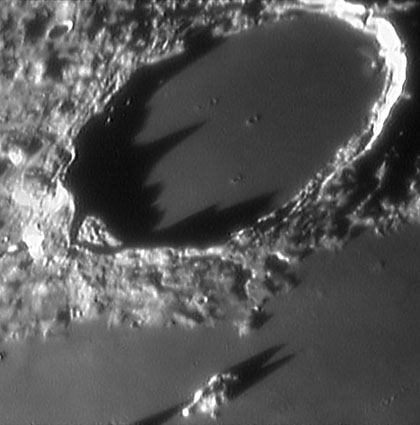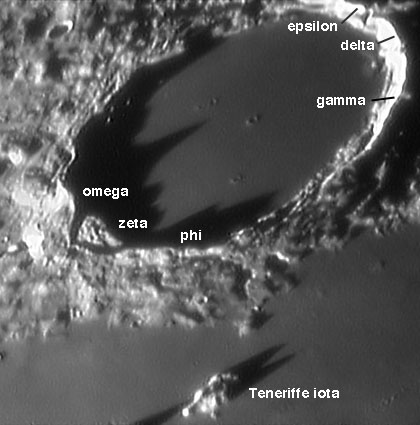June 10, 2004
Peaks of Plato
Image Credit: Wes Higgins
Peaks of Plato The Moon always repays observation. For sociological reasons (sleep and jobs), Plato is commonly studied before midnight, and so the sunrise view with shadows cast by peaks on the eastern ramparts is most familiar. But this wonderful sunset view, taken when the Moon was about 23 days old, reveals long shadows from the western peaks that most of us never see. The longest shadow is about 45 km long; Plato is 101 km wide. Surprisingly, this tallest peak on the western rim doesn't have a Greek letter designation. Most of the Greek letters for lunar mountains were given by Madler and Neison, but all are ignored by the International Astronomical Union because of the difficulty in identifying them. If you mouse over the image above you will see the Greek letters for Plato's rim, taken from the Blagg and Muller IAU map of 1935. I have added two (totally unofficial) additional Greek letters - omega and phi - for the two tallest peaks on Plato's western rim, which strangely lacked letters. The large rim collapse segment was labeled zeta by Madler. There are no spacecraft heights for these peaks that I am aware of , but the US Air Force Chart and Aeronautical Center maps (available most readily in The Times Altas of the Moon, 1969) include the following heights derived from shadow measurements made in the 1960s. As I stated recently there is need for modern determinations/confirmations of peak heights, which will require figuring our peak nomenclature. The IAU isn't going to do it! Technical Details: Originally posted March 15, 2004 Related Links: Yesterday's LPOD: Color Map Tomorrow's LPOD: Pitatus |
Author & Editor:
Charles A. Wood
COMMENTS?
Register, Log in, and join in the comments.





